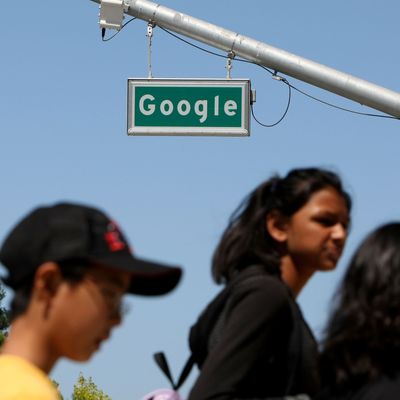
Google’s parent company, Alphabet, announced its quarterly earnings on Monday evening, beating Wall Street expectations and bringing in $39.28 billion in revenue, up 20 percent year-over-year. And yet the company’s stock still slid in after-hours trading. Why are investors feeling skittish about a company minting so much money quarter after quarter?
Part of it is simply how much Google is spending. The company has raised its head count by almost 20,000 since last year, now employing nearly 100,000 people and continuing to spend prodigiously. Overall, it spent nearly $7 billion on capital expenditure projects this quarter, a jump of 80 percent compared to $4.3 billion in the same quarter last year. This bites into Alphabet’s overall margins, which slid from 24 percent to 21 percent.
But the deeper worry is that despite the many things that Google and other companies beneath the Alphabet aegis do, it remains, at heart, a display advertising business. Of the $39 billion it brought in, $32.6 billion of it was in advertising revenue — that’s 83 percent of its total revenue. And underneath, there are small signs of trouble in its ad business. Traffic acquisition costs — the money it pays to companies like Apple to be the default search engine on the iPhone — continue to eat up a good chunk of that advertising revenue, with Google spending $7.44 billion, or about 23 percent of its ad revenue, on getting eyeballs.
The per-click cost on Google’s advertising — an imprecise but generally useful yardstick for how much Google is able to charge advertisers — was down 29 percent compared to last year, and 9 percent from last quarter. Google, for some reason, is having trouble getting advertisers to pay as much. And this isn’t an industry-wide problem; both Amazon and Facebook have continued to successfully increase the amount they charge advertisers.
Google’s main source of competition is not Facebook but Amazon. Amazon reported 97 percent growth in advertising revenue this quarter. Advertising directors speaking to CNBC have said some brands were moving 50 to 60 percent of their ad spending from Google to Amazon.
If I’m Googling “noise-cancelling headphones,” odds are good I’m about to spend some money on headphones, and a company can place an ad right next to my search results. But Amazon is increasingly the place consumers go to look for products, bypassing Google altogether, and advertisers are starting to do the same, advertising directly on the e-commerce platform. And on Amazon, advertisers can see when someone viewing or clicking their ads makes a purchase, something Google can’t do since nearly all of the sales its drives ultimately happen on other sites.
Google is aware of this, which is why its earnings report includes a section titled “Other Bets,” describing efforts like self-driving-car company Waymo, its health company Verily, and the high-speed internet provider Google Fiber. But those Other Bets brought in just $154 million in revenue in the past 90 days; Google’s advertising business makes the same amount of money about every eight hours. And these are very much bets — it lost $3.4 billion on Other Bets in the past year.
Google lumps most everything else into “Other Revenues,” which include its cloud business and hardware sales. Those brought in $6.49 billion during this quarter, a 31 percent increase year-over-year. It’s likely that the majority of that money was in hardware sales, as Google doesn’t break down how much it brings in through hardware versus through cloud services.
And it’s cloud computing where Google should be a major competitor, but it came late to the game, with Amazon’s Web Services dominating, and Microsoft Azure gobbling up larger-enterprise customers. On its earnings call, Google CEO Sundar Pichai said its cloud business was “one of the fastest growing businesses across Alphabet,” but that’s likely a function of how small it is — if I’m earning a dollar a day and then I start earning two dollars a day, I’ve increased my earnings by 100 percent. Impressive on paper, but it still leaves me poor.
Google’s advertising business is the motor that keeps the company running, but it knows that it will need to find other ways of bringing in significant amounts of revenue. But that’s expensive to do, and unlike, say, Amazon, Google has never prided itself on being a lean operation. It was willing to spend $24 billion on research and development last year — but increasingly, investors want to see what else Google can do, and as of right now, nobody seems quite sure what that might be.





























